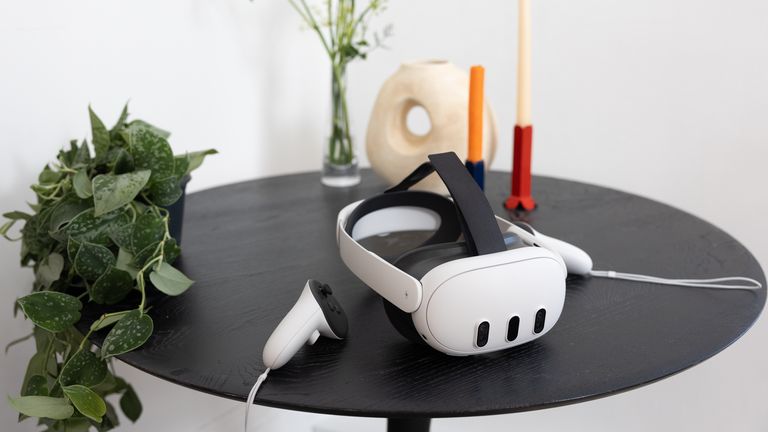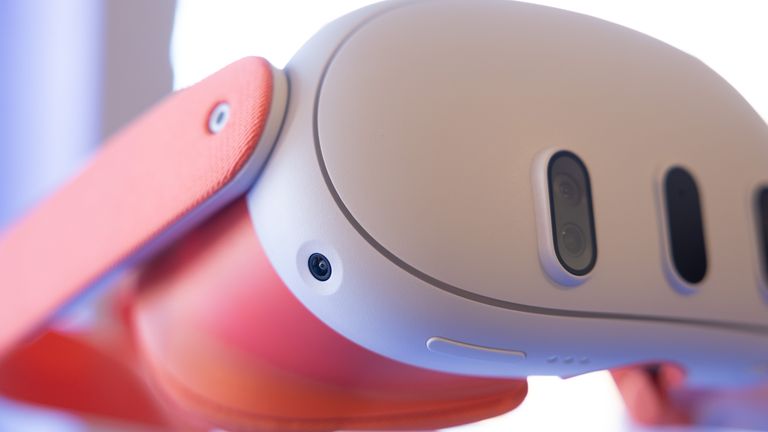Meta has ramped up the race for our faces as it revealed the next generation of its wearable immersive tech products.
The headline announcement: a successor in the Meta Quest series, the Meta Quest 3, and a follow-up to its Ray-Ban Stories smart glasses.
Facebook’s parent company claims the Quest 3 is 40% slimmer than its predecessor and boasts better graphics hardware.
But the main focus this year is on “mixed reality” – an experience that marries up the virtual and real-life surroundings.
I was invited by Meta to try out the new model ahead of release to see whether it manages to keep pace with its numerous rivals in an increasingly competitive market.
A new headstrap made the device feel slightly lighter than the previous model, and I didn’t experience the Quest 2’s interminable issue of fogging – when the lenses would steam up from my breathing – causing me to either repeatedly wipe the display, or hold my breath for uncomfortable periods of time.
The Quest 3 immediately began scanning the room’s walls, floors and objects automatically, a task you previously had to arduously perform manually.
New features and alien games
Once the machine had a good idea of where everything was in the room, Meta demonstrated various apps and games to showcase the mixed reality element.
One game saw aliens crash through your ceiling, blurring the line between reality and game.
Another immersed you in a virtual, abandoned space station, entirely leaving behind the artificial living room Meta had constructed for us.
As someone who doesn’t spend much time in the metaverse, it took some getting used to, and after taking it off and returning to reality, I did feel a bit like a drunk sailor on the high seas.
The developers have cannibalised much of the tech found in their premium Pro model which retails for £1,499.99.
The Quest 3 starts at £499.99 and sports some of the Pro’s biggest hits – such as an enhanced display and the ability to select menu options with just your fingers.
Prohibitive manufacturing costs mean that the Pro’s eye-tracking is not included, and the controllers don’t include rechargeable lithium-ion batteries like you’d find on a PlayStation or Xbox controller.
Accessibility appears to have been a priority for Meta this year, both in cost-efficiency, and user-friendliness.
The new hand-tracking feature makes navigating menus more convenient for when those controllers are out of reach – or when you’ve run out of double A batteries.
The finger-tracking isn’t as precise as using a controller, and sometimes my finger would select the wrong button or resize the window – but it worked most of the time.
What’s the Metaverse for?
The price is arguably competitive when set against its competitors such as the HTC Vive Pro 2 (£1,399) or the PSVR2 (£529.99), for example.
One unavoidable question mark, however, still hangs over Meta’s VR project like the sword of Damocles – the purpose of the ‘Metaverse’ itself.
Meta has invested over $36bn (£29.5bn) in research and development in the Metaverse so far, to seemingly little benefit.
For comparison, Apple spent just over $150m (£123m) in R&D to invent the iPhone.
When asked whether that $36bn could have been better spent on researching AI, a Meta spokesperson told Sky News: “We do spend an awful lot of money on AI, we have been working on AI for over a decade, so I think it’s hard to quantify in that way.”
Following Meta’s announcement of a new chatbot coming to its Messenger app, the



